Sportlyzer news
News about Sportlyzer – speaking up, progress, team, media coverage, etc.
June 3, 2011 -
Posted by Jaan Saks
Last week we asked our users’ opinion about Sportlyzer. Our aim was to find out who are our active users, what are Sportlyzer’s main values for them, what is missed most and so on. Given below is a short overview of the results with some comments from Sportlyzer’s side.
 Our clients are mostly 20-40 years old and besides their favourite endurance sports practice also ball games and gym. The most valuable features according to their opinion are:
Our clients are mostly 20-40 years old and besides their favourite endurance sports practice also ball games and gym. The most valuable features according to their opinion are:
Training advice. Further improvements are on process and more precise feedback and advice are on its way.
Weekly overview, the graph and split between sports (endurance, skill sports and strength training) and heart rate zones.
Goals. It’s nice to see that users have adapted it so well. Goal development (more personalized goals) is in our plans but it’s too soon to give out specific dates.
There are also 3 things that stood out in responses for question “what do you miss most”:
- Specific trainings for each day, more precise advice on the structure of training. It is our top priority and the work on this feature should start any day now. So, be patient – this is worth waiting for ;).
- Better integration with devices such as Garmin, Suunto, Polar and so on. Point taken. Our tech team is already working with the integrations.
- “Totals” (e.g. how many km/miles run during the season, last month’s total etc.). Indeed, it’s not possible to count totals yet, but it is in our to do list and we hope to add it to our new design as soon as possible.
The key point, why people come back to Sportlyzer was mostly similar to the to 3 features, but in addition to that, our Heart Rate zones system got quite a lot of votes. The fact that we’ve managed to educate users to train according to heart rate zones makes us very happy.
There were many other intersting suggestions and we’ve them added all into our roadmap. Thanks for your feedback and while we keep on working with improvements, you keep on giving valuable feedback. So, don’t forget to use Sportlyzer’s feedback feature and/or our forum.
May 16, 2011 -
Posted by Jaan Saks
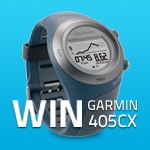 We are happy to announce that we give away Garmin heart rate monitor for the most inspiring sports challenge. Just follow this link here, click “Like” and post your personal sports challenge on Sportlyzer’s Facebook wall. It doesn’t matter if your personal challenge is to run a marathon or just jump higher – all the challenges are more than welcome!
We are happy to announce that we give away Garmin heart rate monitor for the most inspiring sports challenge. Just follow this link here, click “Like” and post your personal sports challenge on Sportlyzer’s Facebook wall. It doesn’t matter if your personal challenge is to run a marathon or just jump higher – all the challenges are more than welcome!
– Five most inspiring challenges will be announced on the 30th of May.
– The winner is the challenge that gets the most likes by the 5th of May.
Check also our campaign page and participate!
April 29, 2011 -
Posted by Jaan Saks
There are many articles about how to stay safe when you go for a run or a bicycle ride after daylight. And yet, people don’t pay much attention to it, because “It doesn’t happen to me.” But it may. So I decided to write about it in Sportlyzer’s blog, too. There are some simple but important things you should follow to stay safe in case you decide to exercise outdoors in the dark.
 Be visible! Wear reflective and bright colors and carry a reliable flashlight – not only to see yourself but to be seen by others. Don’t expect drivers can see you.
Be visible! Wear reflective and bright colors and carry a reliable flashlight – not only to see yourself but to be seen by others. Don’t expect drivers can see you.
Always run against the traffic. This way you will have a better view of the vechicles approaching.
Make sure you know the surroundings and/or inform someone about your plans. When you decide to exercise in a new place (e.g. you are on a business trip or you’ve chosen a new route), make sure you know in which kind of area you are exercising (avoid dark areas and side streets), and make sure you inform a friend/family member about your plans. And of course, choose a well-lit route.
Carry an identification or make sure your name, phone number and blood type is written somewhere on your training clothes/shoes.
Don’t exercise alone. If possible, invite a friend or take your dog with you.
 Leave your iPod or MP3 player at home. You can’t hear oncoming cars, dogs, or any other potential threat. Cutting of your sense of hearing leaves you at a disadvantage even in daylight but it’s especially dangerous in the dark.
Leave your iPod or MP3 player at home. You can’t hear oncoming cars, dogs, or any other potential threat. Cutting of your sense of hearing leaves you at a disadvantage even in daylight but it’s especially dangerous in the dark.
Carry a cell phone or whistle in case you need help.
It’s not necessary to memorize the whole list or completely avoid exercising in the dark but it’s important to do it with some sense of caution. Common sense helps you to avoid most of the potential threats.
April 21, 2011 -
Posted by Jaan Saks
It is time to color Easter eggs and spend some quality time with your family!
Holiday weekends are usually full of plans and events with family and friends.  Different plans pile up fast and workouts tend to be outnumbered in comparison with all the other plans. So, I just wanted to remind you to spare some time for exercising, too. It’s OK if you exercise just a little every day – for example 15 minutes light running a day, or 60 minutes extra walking in 3 days. It helps to keep you in shape and you can continue with your regular workout plan next week without any problems. And all those who are planning to have a bigger meal on Sunday, remember – you can eat more if you train more ;).
Different plans pile up fast and workouts tend to be outnumbered in comparison with all the other plans. So, I just wanted to remind you to spare some time for exercising, too. It’s OK if you exercise just a little every day – for example 15 minutes light running a day, or 60 minutes extra walking in 3 days. It helps to keep you in shape and you can continue with your regular workout plan next week without any problems. And all those who are planning to have a bigger meal on Sunday, remember – you can eat more if you train more ;).
Enjoy your long weekend and see you next week!
March 22, 2011 -
Posted by Jaan Saks
Sportlyzer launched a virtual trainer that focuses on training advice – a required supplement to numerous exercise tracking applications and devices. Sportlyzer is providing a virtual trainer that uses complex algorithms to compose and modify workout plans and give training advice based on a user’s previous workouts and current training schedule. Just as well as a real trainer. This major step is the result of months of hard work and development – yet it is just the beginning of the next generation virtual trainer.
Sportlyzer’s uniqueness is based on 2 core features:
- Relevant training advice delivered by the virtual trainer
- Uniquely tailored training plans which adapt to changes.
The virtual trainer is supported by social networking which enables users to do numerous training related things. Hereby we would like to give a short overview about the possibilities in the public beta.
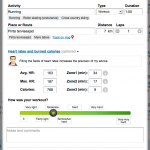 Workout log.
Workout log.
Adding and editing workouts is made easy. Workouts can be added either manually or from a heart rate monitor (Polar .hrm and .gpx are currently supported types). It is also possible to add multiple workouts to the same day.
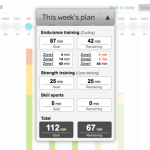 Goal setting and individual workout plans.
Goal setting and individual workout plans.
Based on physical characteristics, goals and previous workout history, Sportlyzer’s algorithms tailor a unique workout plan for each user. Workout plans are flexible to changes and are therefore modified after every change in scheduled workouts.
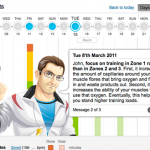 Training advice from the virtual trainer.
Training advice from the virtual trainer.
Virtual trainer gives training advice based on individual workout plan and data from previous workouts: suggests training loads and warns if user’s training load is too high or too low. As common in newer sports practices, the training advice is concentrated on heart rate zones and minutes instead of kilometers/miles. Explanations are available for the beginners and to those who are new to this system.
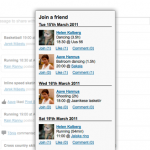 Workout community and shared training routes.
Workout community and shared training routes.
One of the most common reasons why people skip workouts is lack of people to train with. “Community” and “Join a friend” tools in Sportlyzer enable users to share workouts and join friends’ trainings with just one click. Besides trainings, it is also possible to track your favourite routes on map and “borrow” interesting training routes from your friends.
Sportlyzer’s team is working with further improvements. Until then, everyone is welcome to join, try and give us feedback, so we could tailor our virtual trainer according to our users’ needs.

February 3, 2011 -
Posted by Jaan Saks
Have you ever felt tired and drained out at the end of a long workday or at the end of the week? Tempted to skip the workouts you have planned for yourself? Tiredness is one of the most common reasons to skip exercise but there are ways to make it work, even when there is no energy left.

Strangely enough, people tend to skip pleasant activities when feeling bad. It is often tempting to skip workout because of fatigue and boredom and read a nice book or have a glass of wine or beer instead. Actually, it is very human to be irrational. And yet, it is even more human to do something about it! There are several easy ways to overcome those little motivation crisis. Hereby I would like to share a few of them with you:
- Think outside the box! On those days when you feel tired and your typical training routine doesn’t motivate you enough to leave the couch, think of the activities that you have enjoyed in the past. Maybe you used to play badminton when you were a kid or perhaps enjoyed swimming? Just try something different to spice up your typical workout routine.
- Invite or join a friend! It’s always harder to hoax a friend than yourself – having a common workout time is always a good laziness killer.
- Choose an easier exercise! While being very tired, even a thought about a hard workout makes you want reject it. So, instead of skipping your workout, go for an easier one.
- Try morning workouts! If you are a morning person, try to go for a morning run or swimming before work. It makes you feel fresh and finding a training motivation is also easier. However, if you are not a morning person, even 5-10 minutes of exercising in the morning increases your metabolism and wakes you up.
- Use weekends! If you are too tired to work out on workdays, try to pitch just training or two into your working days and leave the rest for the weekend. In that case try to balance this with workouts on both weekend days.
- Take the training bag with you! In case you prefer to work out during workdays but still struggle with training motivation from time to time, the easiest way is to take your training bag with you to work and go to training directly from work without meeting your couch in between. It is a simple advice but it really works.
So, just take a moment and think about how you can make starting a workout more appealing. You may feel tired at this very moment but this feeling alone does not preclude your workout, the feeling does not step in your way and hold you back. You can very well take your tiredness together with you to the gym and leave it there ;)
January 20, 2011 -
Posted by Jaan Saks
Until now we have talked about problems related to too few exercise. However, believe it or not, some people suffer from too much exercise, a condition called exercise addiction.
 Individuals with exercise addiction train at a duration, intensity, and frequency beyond that required for healthy exercise and reasonable working load. Most often, people with exercise addiction try to maintain a rigid schedule of intense exercise, and feel guilty when this schedule is violated. Moreover, physical signs similar to drug addictions appear: exercise addicts skip school or work, they forget social and family events, exercise even when ill or tired, and keep detailed training journals of their workouts. For instance, some people reject challenging carreer opportunities in order to get a job as a coach in the gym and be able to exercise whenever possible.
Individuals with exercise addiction train at a duration, intensity, and frequency beyond that required for healthy exercise and reasonable working load. Most often, people with exercise addiction try to maintain a rigid schedule of intense exercise, and feel guilty when this schedule is violated. Moreover, physical signs similar to drug addictions appear: exercise addicts skip school or work, they forget social and family events, exercise even when ill or tired, and keep detailed training journals of their workouts. For instance, some people reject challenging carreer opportunities in order to get a job as a coach in the gym and be able to exercise whenever possible.
Have you met someone whose commitment to exercise has become a compulsion? Like other addictions, exercise addiction may include physical & psychological addiction. The drive prevents normal life, it starts to interfere instead of enhancing someone’s life. Intense exercise dependence can lead to permanent physical damage, as the body is not allowed to recuperate between workouts. Psychologically, exercise addicts feel unable to stop exercising. Specifically, exercise addiction is characterized by deep feeling of dread when a workout is missed. Addicts experience loss and disappointment when an exercise “high” is not attained. The workout schedule of an addict is very strict, the nature of the workout activity is usually simple and does not include much intellectual challenge. Mostly, addicts exercise alone similar to drinkers drinking alone.
What would help? Exercise addicts get relief when introducing noncompetitive and versatile activities delivering fun, not just removing feelings of guilt. The most important tip is to plan resting days as well as to alternate the nature, duration, and intensity of workouts. Remember, less is sometimes more.
December 30, 2010 -
Posted by Jaan Saks
For many people, mixed feelings of dread and bad expectations arise in the final days of a year. But such a dread can also be accompanied by expectations full of wonderful promise. The promise of Christmas is followed by the promise of New Year’s Day – a time for new beginnings and resolutions aimed at changes for the better. Those are our unrealistic expectations and attitudes that give rise to our bad expectations:
 Aim for your destination, concentrate on the journey. How pleasant it feels to dream about the happy, healthy, and productive person I’ll become after I have got down to it on the January 1st! However, willpower is not enough for long-term success. Willpower is just a good basis for careful goal setting and planning.
Aim for your destination, concentrate on the journey. How pleasant it feels to dream about the happy, healthy, and productive person I’ll become after I have got down to it on the January 1st! However, willpower is not enough for long-term success. Willpower is just a good basis for careful goal setting and planning.
Motivation evolves from small successes. Even if you feel full of power for big changes, only keeping the ultimate outcome in mind most likely won’t help you for long time. Break down large goals into smaller ones, and keep your concentration on the closest one. For instance, if your resolution is to lose 8 kg, then joining a swimming club and improving your eating habits are two general action plans. Now, list all steps that are required to take, accompanied by target dates and strategies for maintaining new habits once you reach your goal. A SMART specific action goal for the first week could be two swimming workouts of 30 minutes each. This is a specific, measurable, action-oriented, realistic, and time-related goal. Even if you didn’t lose any weight by the end of the week, you are one step closer to your ultimate goal – you have already changed your habits.
Make a daring Plan B. If you aim your goal, it is wise to make plans for setbacks. One could think about alternative workouts that can be grabbed at when swimming plan is changed by holydays, betraying exercise buddies or simple boredom.
Happy New Year’s resolutions!
December 15, 2010 -
Posted by Jaan Saks
Finding the motivation to train or do exercise on a regular basis isn’t always easy. Demanding schedules and illness are just a couple of the things that can interrupt your fitness routine. Motivation can be found by following the SMART approach to goal setting. Many athletes, coaches and serial exercisers use this formula successfully to set both short and long-term training goals.

Setting your goals – remember be SMART:
- Specific – these are the most motivating goals. A specific goal is to reduce the time you take to swim 1000 m from 30 minutes to 20 minutes within 6 months. Quite often people just say they want to get faster. That is far too general to really motivate you in the pool.
- Measurable – it means that simply saying that you want to get faster is not enough. You need to be able to map the progress toward your goal. One way to measure your progress is to assess your performance at set intervals. In the above example you may want to time your 1000 m swim twice a month.
- Adjustable and Action-Oriented – goals help you only if they are flexible enough to allow for unexpected changes. An illness or injury may force you to readjust your goal. It doesn’t need to mean abandoning all your plans and dreams, you just need to find another way to action them. Importantly, keep your plans focused on your actions. Quite often people focus only on what they want to achieve, but forget to plan how to achieve it.
- Realistic – base your goals on your actual situation. If you never swam 1000 m, start by planning small sub-goals. Swimming 1000 m in 20 minutes is a perfect long-term goal, but in the short-term you may want to shoot for 35 minutes. This is a healthy and realistic plan. On the other hand, if goals are too easy, you won’t get much satisfaction from attaining them.
- Time-related – connect your measurable, realistic and challenging goals to your schedule. In our example this would be to reduce the time taken to swim 1000 m within 6 months. You may also need to set interim goals with shorter timelines to keep your landmarks in view. Note that having only goals that are achievable in more than 6 months, will make heavy demands on your motivation. Try to re-evaluate your progress every 2-3 months.
Last but not least, goal setting is not actually a prerequisite for attaining your goals. Nor can setting goals ever guarantee achievement of those goals – because all sorts of obstacles can hold you up. However, goal-setting is a tried and trusted technique to improve concentration and motivation, and so it increases the likelihood of achieving your dreams.
November 19, 2010 -
Posted by Tõnis Saag
(Sorry, folks, this post is in Estonian – a job offer for a PHP programmer in Estonia.)
Sportlyzer OÜ tegeleb virtuaalse treeneri väljatöötamisega tervisesportlastele. Eesmärk on luua algoritmidel põhinev veebirakendus, mis analüüsib ja nõustab tervisesportlaste treeninguid.

Kui Sa oled:
- PHP/JavaScript programmeerija,
- huvitatud globaalses ja ambitsioonikas projektis kaasalöömisest,
- valmis töötama Tartus,
siis pakume Sulle huvitavat tööd, mille ülesannete hulka kuuluvad:
- suure kasutatavusega veebipõhise tarkvararakenduse programmeerimine
- testimine ja juurutamine
- tarkvararakenduste parandamine, täiendamine
- osalemine tarkvaraarenduse planeerimises ja lähteülesannete koostamises
Oled õige inimene meie tiimiga liituma, kui:
- valdad PHP-d ja Javascripti
- valdad MySQL-i
- Sul on eelnev töökogemus tarkvaraarendajana
- valdad hästi inglise keelt
Kasuks tuleb:
- IT- või informaatika-alane kõrgharidus
- arusaamine agiilsest ehk välearendusest
- kiire õppimisvõime ja hea suhtlusoskus
Sportlyzer pakub Sulle:
- kogemusel baseeruvat konkurentsivõimelist töötasu (võimalik on ka optsiooni saamine),
- globaalse ambitsiooniga projektis kaasalöömise võimalust,
- väikest ja motiveeritud meeskonda,
- startup-i inspireerivat atmosfääri.
Võta ühendust ja küsi täpsemalt!
Kontaktisik: Tõnis Saag, tonis (ät) sportlyzer.com, +372 5690 4988
 Our clients are mostly 20-40 years old and besides their favourite endurance sports practice also ball games and gym. The most valuable features according to their opinion are:
Our clients are mostly 20-40 years old and besides their favourite endurance sports practice also ball games and gym. The most valuable features according to their opinion are: We are happy to announce that we give away Garmin heart rate monitor for the most inspiring sports challenge. Just follow this link
We are happy to announce that we give away Garmin heart rate monitor for the most inspiring sports challenge. Just follow this link  Be visible! Wear reflective and bright colors and carry a reliable flashlight – not only to see yourself but to be seen by others. Don’t expect drivers can see you.
Be visible! Wear reflective and bright colors and carry a reliable flashlight – not only to see yourself but to be seen by others. Don’t expect drivers can see you.
 Leave your iPod or MP3 player at home. You can’t hear oncoming cars, dogs, or any other potential threat. Cutting of your sense of hearing leaves you at a disadvantage even in daylight but it’s especially dangerous in the dark.
Leave your iPod or MP3 player at home. You can’t hear oncoming cars, dogs, or any other potential threat. Cutting of your sense of hearing leaves you at a disadvantage even in daylight but it’s especially dangerous in the dark. Different plans pile up fast and workouts tend to be outnumbered in comparison with all the other plans. So, I just wanted to remind you to spare some time for exercising, too. It’s OK if you exercise just a little every day – for example 15 minutes light running a day, or 60 minutes extra walking in 3 days. It helps to keep you in shape and you can continue with your regular workout plan next week without any problems. And all those who are planning to have a bigger meal on Sunday, remember – you can eat more if you train more ;).
Different plans pile up fast and workouts tend to be outnumbered in comparison with all the other plans. So, I just wanted to remind you to spare some time for exercising, too. It’s OK if you exercise just a little every day – for example 15 minutes light running a day, or 60 minutes extra walking in 3 days. It helps to keep you in shape and you can continue with your regular workout plan next week without any problems. And all those who are planning to have a bigger meal on Sunday, remember – you can eat more if you train more ;).





 Individuals with exercise addiction train at a duration, intensity, and frequency beyond that required for healthy exercise and reasonable working load. Most often, people with exercise addiction try to maintain a rigid schedule of intense exercise, and feel guilty when this schedule is violated. Moreover, physical signs similar to drug addictions appear: exercise addicts skip school or work, they forget social and family events, exercise even when ill or tired, and keep detailed training journals of their workouts. For instance, some people reject challenging carreer opportunities in order to get a job as a coach in the gym and be able to exercise whenever possible.
Individuals with exercise addiction train at a duration, intensity, and frequency beyond that required for healthy exercise and reasonable working load. Most often, people with exercise addiction try to maintain a rigid schedule of intense exercise, and feel guilty when this schedule is violated. Moreover, physical signs similar to drug addictions appear: exercise addicts skip school or work, they forget social and family events, exercise even when ill or tired, and keep detailed training journals of their workouts. For instance, some people reject challenging carreer opportunities in order to get a job as a coach in the gym and be able to exercise whenever possible. Aim for your destination, concentrate on the journey. How pleasant it feels to dream about the happy, healthy, and productive person I’ll become after I have got down to it on the January 1st! However, willpower is not enough for long-term success. Willpower is just a good basis for careful goal setting and planning.
Aim for your destination, concentrate on the journey. How pleasant it feels to dream about the happy, healthy, and productive person I’ll become after I have got down to it on the January 1st! However, willpower is not enough for long-term success. Willpower is just a good basis for careful goal setting and planning.
